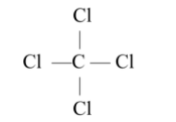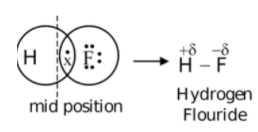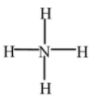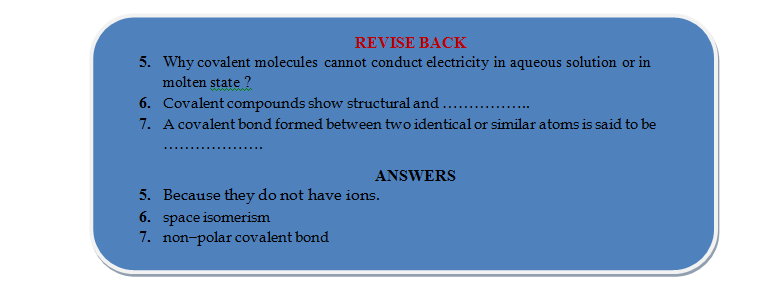COVALENT BOND
Chemical Bonding of Class 9
Lewis concept
G. N. Lewis was the first to suggest, that atoms may combine with one another by sharing of electrons in their valence shells so that the combining atoms attain the nearest noble gas configurations in their valence shells. The shared electrons contribute towards the stability of both the atoms. This type of linkage is known as covalent bond. The compounds formed by this mechanism are known as covalent compounds. According to Lewis concept, the number of electrons which an atom contributes for sharing in a covalent bond is called its covalency.
For Examples: Let us consider the formation of a hydrogen molecule from two hydrogen atoms. Each hydrogen atom has only one electron and thus its configuration is unstable, but when both the hydrogen atoms share their electrons to form a pair of electrons equally shared between the two atoms i.e., the pair of electrons becomes a common property of two hydrogen atoms; the resulting molecule acquire helium configuration. The covalent bond is represented by a dash (−)
H − H
(Hydrogen)
Similarly, the formation of carbon tetrachloride takes place.

(Carbon tetrachloride)
Decrease of Energy in Formation of Hydrogen Molecule
The formation of a chemical bond of any type is possible only if the approach of the atoms towards one another is accompanied by decrease in energy. When any two atoms approach each other, new forces of attraction, and repulsion are set up due to the nucleus and electrons of both atoms. If the net result is attraction the total energy of the system decreases and a chemical bond results and if the net result is repulsion, the total energy of the system increases and no chemical bond is possible.
In case of hydrogen when two atoms are brought closer and closer, the electrostatic potential energy goes on decreasing because attractive forces go on becoming more and more dominant and at this stage bond between hydrogen atoms is possible.
Properties of covalent compounds
- Under ordinary conditions covalent molecules may exist in gaseous, liquid or solid state.
- Covalent molecules are molecules in nature in all the states. For example CO2 is covalent compound in gaseous as well as in solid state.
- Melting and boiling points of covalent compounds are much lower in comparison to electrovalent compounds. This is due to weak van der Waals forces of attraction between covalent molecules. Hence less energy is required to separate the molecules.
- Generally covalent molecules are insoluble in water but dissolve in organic solvents like in benzene CS2, CCl4, ethers etc.
- Covalent molecules do not conduct electricity in aqueous solution or in molten state because they do not have ions.
- (Covalent compounds show structural and space isomerism because covalent bond is rigid and directional
- Due to low melting and boiling point, covalent solids or liquids are more volatile than ionic compounds and hence have higher vapour pressure.
- Covalent compounds show molecular reactions which are quite slow and complex.
Coordinate Covalent Bond or Dative Bond
Lewis proposed that a different type of covalent bond can be formed when both the electrons for sharing between the atoms are contributed by one atom only. This type of bond is known as coordinate covalent bond or dative bond.
A coordinate covalent bond is established between two atoms one of which has a complete octet and at the same time posses at least one pair of unshared electrons while the other is short of two electrons. The former atom contributes one such pair of electrons for mutual sharing between the two atoms as a result of which the second atom also completes its octet and acquires a stable noble gas configuration. The atom, which contributes the pair of electrons, is known as the donar and the atom, which accepts these electrons, is called the acceptor.
For Example:
(i) Even though the ammonia molecule has a stable electronic configuration it can react with a hydrogen ion (H+) by donating a lone pair of electrons forming the ammonium ion  .
.

(Ammonium ion)
Covalent bonds are usually shown a straight line joining the two atoms, and coordinate bonds as arrows indicating which atom is donating the electron.
(ii) Similarly ammonia may donate its lone pair to boron trifluoride and by this means the boron atom attains noble gas configuration.

Ammonia Borontriflouride
(iii) In a similar way a molecule of BF3 can form a coordinate bond by accepting a a lone pair from a F− ion.

Boron Tetraflouride
(iv) 


Non polar and polar covalent bond
A covalent bond formed between two identical or similar atoms is said to be a non−polar covalent bond but if formed between two dissimilar atoms, the bond formed is said to be a polar covalent bond. The reason is that in the former case the shared electron pair is attracted equally by both atoms and lie exactly midway between them, as in hydrogen molecule, H : H. The molecule formed is known as non polar molecule.
In the case of a covalent bond formed between two dissimilar atoms one of the atoms generally has a greater tendency to attract the electrons towards itself. The electron pair is therefore, pulled closer to that atom as in hydrogen fluoride molecule, in which the electron pair shared between hydrogen and fluorine atoms remains closer to the fluorine atom. This unsymmetrical distribution of electrons leads to development of partial negative and partial positive charges on atoms. The molecule formed is known as a polar molecule.

Now we present three methods by which structure and shapes of molecules can be predicted
Method I: Applicable for molecules in which octet rule is not violated.
- Determine the total number of valence electrons in all the atoms present, including the net charge on the species (n1)
- Determine n2 = [2 × (number of H atoms) + 8 × (number of other atoms)].
- Determine the number of bonding electrons, n3, which equals n2-n1. Number of bonds equals n3/2.
- Determine the number of non-bonding electrons, n4, which equals n1- n3. Number of lone pairs equals n4/2.
- Knowing the central atom (you'll need to know some chemistry here, math will not help!), arrange and distribute other atoms and n3/2 bonds. Then complete octets using n4/2 lone pairs.
- Determine the `formal charge' on each atom.
- Formal charge =[(valence electrons in atom)-(number of bonds) − (number of unshared electrons)]
- Locate co−ordinate bonds. Every pair of atoms having formal charges +1 and −1 bonded to each other, have a co−ordinate bond between them.
- Draw all possibilities. These possibilities have to be drawn without changing the shape, position of atoms and by only altering the position of electrons. These possibilities are called resonance structures.
example:1 CN−
Solution n1=10, n2=16, n3=6 ∴ Number of bonds = 3
n4=4 ∴ Number of lone pairs = 2.
Thus the structure of CN− using, the number of bonds and lone-pairs, would be

(Cyanide ion)
example:2 CO2
Solution n1 = 4+(6 × 2) = 16
n2 = (2 × 0) + (8 × 3) = 24
n3 = 24 -16 = 8, hence 4 bonds
n4 = 16 - 8 = 8, hence 4 lone-pairs.
Since C is the central atom, arrange the two oxygen atoms around it thus the structure would be; O-C-O, but total number of bonds = 4
Hence we get O=C=O.
Arrange lone pairs to complete octets
Figure out the formal charges and get the final structure;
 ↔
↔ ↔
↔
(Carbon dioxide)
example:3 CO
Solution n1= 10; n2= 16; n3=6 ∴ Number of bonds = 3
n4=4 ∴ number of lone-pairs =2.
Since C is the central atom, arrange the oxygen atom using the number of bonds and complete octets. Thus, we get

Figure out the formal charge and we get;  or
or 
(Carbon monoxide)
example:4 
Solution n1=18 , n2=24, n3=6 ∴ Number of bonds = 3
n4=12 ∴ Number of lone pairs = 6
Since N is the central atom, arrange the two oxygen atoms around N using the number of bonds and lone-pairs. Hence we get,
 or
or  ↔
↔
Figure out the formal charge and we get;
example:5 
Solution n1 = 4 + (6 × 3) + 2 = 24 [2 added for net negative charge]
n2 = (2 × 0) + (8 × 4) = 32 (no H atom, 4 other atoms (1‘C’ and 3 ‘O’)
n3 = 32 - 24 = 8, hence 8/2 = 4 bonds
n4 = 24 - 8 = 16, hence 8 lone pairs.
Since carbon is the central atom, arrange 3 oxygen atoms around it, thus,  , but total bonds equal 4.
, but total bonds equal 4.
Hence we get  .Now, arrange lone pairs to complete octets
.Now, arrange lone pairs to complete octets 
Figure out the formal charges to get  ↔
↔ ↔
↔
(Carbonate ion)
example:6 
Solution n1 = 24, n2 = 32, n3 = 8 ∴ Number of bonds = 4
n4 = 16 ∴ Number of lone pairs = 8
Since N is the central atom, arrange the three oxygen atoms around the N atom using the number of bonds and number of lone pairs.
Hence we get, 
Figure out the formal charge and we get


(Nitrate ion)
example:7 
Solution n1 = 8, n2 = 16, n3 = 8, ∴ Number of bonds = 4; n4 = 0
Since N is the central atom, arrange the four H atoms around the N atom using the number of bonds.
Thus we get,
 or
or 
(Ammonium Ion)
The method for determining Lewis structures described above does not hold good for species in which the octet rule is violated (this should be obvious from the procedure. Why ?).
It is therefore useful to remember some important categories of exceptions:
1. Odd-electron species like NO, NO2,ClO2 etc. Since it is impossible to distribute an odd number of electrons into pairs, these species necessarily violate the octet rule.
2. Species in which the central atom `expands' its octet (so to speak) PCl5, SF6, many transition metal compounds etc.
3. Electron -deficient species like BCl3, BeCl2, AlCl3, B2H6 etc. in which the central atom has fewer than eight electrons.










